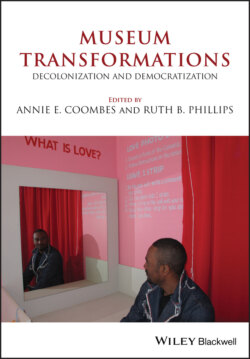Читать книгу Museum Transformations - Группа авторов - Страница 63
References
ОглавлениеAdams, James. 2011. “Poll Rejects Museum’s Plan to Set Holocaust Apart from Other genocides.” Globe and Mail, March 23. Accessed April 8, 2014. http://www.the globeandmail.com/arts/poll-adds-to-controversy-over-rights-museums-holocaust-program/article591189/.
Aran, Lydia. 2005. “The Forgotten Dead: Representations of the Past in the Tibetan Refugee Community in India.” In Genocide: Approaches, Case Studies and Responses, edited by Graham C. Kinloch and Raj P. Mohan, 195–216. New York: Algora.
Barnett, Robert. 2001. “Violated Specialness: Western Political Representations of Tibet.” In Imagining Tibet: Perceptions, Projections and Fantasies, edited by Thierry Dodin and Heinz Räther, 269–316. Boston: Wisdom.
Chopra, Radhika. 2013. “A Museum, a Memorial and a Martyr: Politics of Memory in the Sikh Golden Temple.” Sikh Formations: Religion, Culture, Theory 9(2): 1–18. doi:10.108 0/17448727.2013.822142.
Das, Veena. 1992. “Time, Self and Community: Features of the Sikh Militant Discourse.” Contributions to Indian Sociology 26(2): 245–259.
Dodin, Thierry, and Heinz Räther. 2001. “Imagining Tibet: Between Shangri-la and Feudal Oppression: Attempting a Synthesis.” In Imagining Tibet: Perceptions, Projections, and Fantasies, edited by Thierry Dodin and Heinz Räther, 391–416. Boston: Wisdom.
Dvir, Noam. 2012. “Israeli Architecture with Eastern Promise.” Haaretz Weekend, February 3. Accessed April 8, 2014. http://www.haaretz.com/weekend/week-s-end/israeli-architecture-with-eastern-promise-1.410815.
Fenech, Louis E. 2000. Martyrdom in the Sikh Tradition: Playing the “Game of Love.” New Delhi: Oxford University Press.
Harris, Clare. 1999. In the Image of Tibet: Tibetan Painting After 1959. London: Reaktion.
Harris, Clare. 2012. The Museum on the Roof of the World: Art, Politics, and the Representation of Tibet. Chicago: University of Chicago Press.
Huber, Toni. 2001. “Shangri-la in Exile: Representations of Tibetan Identity and Transnational Culture.” In Imagining Tibet: Perceptions, Projections and Fantasies, edited by Thierry Dodin and Heinz Räther, 357–372. Boston: Wisdom.
Huyssen, Andreas. 2003. Present Pasts: Urban Palimpsests and the Politics of Memory. Stanford: Stanford University Press.
Jodhka, Surinder Singh. 2001. “Looking Back at the Khalistan Movement: Some Recent Researches on Its Rise and Decline.” Economic and Political Weekly 36(16): 1311–1313, 1315–1318.
Kamenetz, Rodger. 1994. The Jew in the Lotus. San Francisco: HarperCollins.
Lakshmi, Rama. 2012. “Curating a Bhopal People’s Movement: An Opportunity for Indian Museums.” Curator, 55(1): 35–50.
Linenthal, Edward T. 1995. Preserving Memory: The Struggle to Create America’s Holocaust Museum. New York: Viking.
Lopez, Donald S., Jr. 1998. Prisoners of Shangri-La: Tibetan Buddhism and the West. Chicago: University of Chicago Press.
MacFarquhar, Larissa. 2003. “Truth in Architecture.” New Yorker, January 20. Accessed April 8, 2014. http://www.newyorker.com/archive/2003/01/20/030120fa_fact_macfarquhar.
Mahmood, Cynthia Keppley. 1996. Fighting For Faith and Nation: Dialogues with Sikh Militants. Philadelphia: University of Pennsylvania Press.
Margalit, Avishai. 1988. “The Kitsch of Israel.” New York Review of Books, November 24, 20–23.
Ngawang Lobsang Yishey Tenzing Gyatso, Dalai Lama. 1962. My Land and My People. New York: McGraw-Hill.
Norbu, Jamyang. 2001. “Behind the Lost Horizon: Demystifying Tibet.” In Imagining Tibet: Perceptions, Projections and Fantasies, edited by Thierry Dodin and Heinz Räther, 373–378. Boston: Wisdom.
Norbu, Jamyang. 2004. “Unquiet Memories.” In Shadow Tibet, 113–129. New Delhi: Blue Jay.
Oberoi, Harjot. 1994. The Construction of Religious Boundaries: Culture, Identity and Diversity in the Sikh Tradition. New Delhi: Oxford University Press.
Pettigrew, Joyce. 1991. “Betrayal and Nation-Building among the Sikhs.” Journal of Commonwealth and Comparative Politics 29(1): 25–43.
Randhawa, Mohinder Singh. 1978–1979. “The Artist who Made Alive the History of the Punjab.” Rooplekha 50(1–2): 30–35.
Safdie Architects. 2011. “Khalsa Heritage Centre, Designed by Moshe Safdie, to be Inaugurated November 25, 2011 in Anandpur Sahib, India.” Safdie Architects press release. Accessed April 8, 2014. http://www.msafdie.com/file/3997.pdf.
Safdie, Moshe. 2006. “The Architecture of Memory.” In Yad Vashem: Moshe Safdie: The Architecture of Memory, edited by Joan Ockman, Moshe Safdie, and Diana Murphy, 92–101. Baden, Germany: Müller.
Singh, Kavita. 2010. “Repatriation without Patria: Repatriating for Tibet.” Journal of Material Culture 15(2): 131–155.
Smith, Laurajane. 2006. Uses of Heritage. Abingdon, UK: Routledge.
Sonam, Bhuchung D., ed. 2013. Tibetan Self-Immolations 1998 to 2012: News, Views and Global Response. Dharamsala, India: Kirti Monastery.
Steiman, Lionel. 2007. “Whose Rights? From Holocaust to Human Rights.” Outlook Magazine Brunch Section. Accessed April 8, 2014. http://canisa.org/1/post/2011/12/whose-rights-from-holocaust-to-human-rights-the-canadian-museum-for-human-rights.html.
Tibet Museum. 2000. A Long Look Homeward: Exhibition Catalog. Dharamsala, India: Tibet Museum.
Williams, Paul. 2007. Memorial Museums: The Global Rush to Commemorate Atrocities. New York: Berg.
Yeshi, Kim. 2006. “The Norbulingka Institute – The Beginning: A Personal Memoir.” In Norbulingka – The First Ten Years of an Adventure, edited by Jeremy Russel, 11–38. Dharamsala: Norbulingka Institute.
Young, James E. 1993. The Texture of Memory: Holocaust Memorials and Meaning. New Haven: Yale University Press.
Kavita Singh is Associate Professor for Art History at the School of Arts and Aesthetics, Jawaharlal Nehru University, New Delhi. Her research and teaching interests include the history of Indian painting and the history and politics of Indian museums, particularly in the postcolonial period. She has received grants and fellowships from the Getty Foundation, the Max Planck Institute, the Clark Art Institute, the Victoria & Albert Museum, and the Asia Society.
